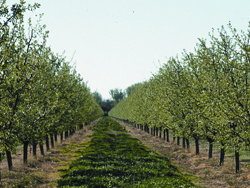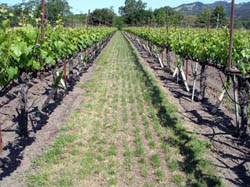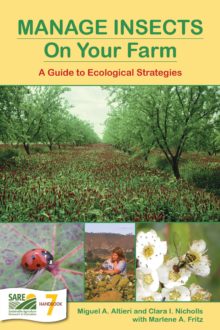Managing Aboveground Habitat

Diversify plants within agroecosystems. You can attract natural enemies and improve biological pest control by planting polycultures of annual crops — two or more crops simultaneously growing in close proximity. You can also let some flowering weeds reach tolerable levels or use cover crops such as buckwheat or sunflowers under orchards and vineyards.
For three decades, Dick Thompson has planted cover crops, managed weeds like covers instead of like pests, and lengthened and expanded his crop rotation. “I’m not saying we don’t have any insect problems, but they do not constitute a crisis,” says Thompson, who farms in Boone, Iowa. “We don’t have to treat for them. We haven’t done that for years.”
Numerous researchers have shown that increasing plant diversity — and thereby habitat diversity — favors the abundance and effectiveness of natural enemies:

- In the Latin American tropics, lower numbers of leafhoppers and leaf beetles have been reported in small farms where beans are intercropped with corn. Corn earworm populations were reduced when corn was intercropped with legumes.
- In Canadian apple orchards, 4 to 18 times as many pests were parasitized when wildflowers were numerous compared to when they were few. In this research, wild parsnip, wild carrot and buttercup proved essential to maintaining populations of a number of parasitoids.
- In California organic vineyards, growing buckwheat and sunflowers between the vines attracts general predators as well as the leafhopper egg wasp (Anagrus species) to help manage grape leafhoppers and thrips. When these summer-blooming cover crops flower early, they allow populations of beneficials to surge ahead of pests. When they keep flowering throughout the growing season, they provide constant supplies of pollen, nectar and alternative prey. Mowing every other row of cover crops is a management practice that forces those beneficials out of the resource-rich cover crops and into vines.
- Georgia cotton fields strip-cropped with alfalfa or sorghum had higher populations of natural enemies that attack moth and butterfly pests. Beneficials reduced pest insects below economic threshold levels in cotton that was relay-cropped with crimson clover, eliminating the need for insecticides.
- At Michigan State University, researchers discouraged potato leafhoppers in alfalfa by adding forage grasses to alfalfa stands. The grasses don’t provide the leafhoppers with enough nutrition to develop eggs, but the leafhoppers feed on them anyway for 5 to 8 minutes before trying another plant and eventually flying away. By diverting leafhoppers from alfalfa and by increasing their chances for dispersal, alfalfa-orchardgrass mixtures held 30 percent fewer leafhoppers than pure alfalfa stands. Because potato leafhoppers are often controlled later in the season by a naturally occurring fungus, this strategy may reduce leafhopper damage below threshold levels.
TIP:
Grow two or more crops — such as corn and beans, or cabbage and fava beans — simultaneously to boost beneficial populations.
CAUTION:
Before introducing additional crop(s) into your system, be sure to consider the possibility that the new crop may compete for water, nutrients, light or other resources needed by the cash crop for optimal growth. Seek local knowledge and/or test the new system on a small portion of your acreage. How might a very wet or a very dry year affect your results?
